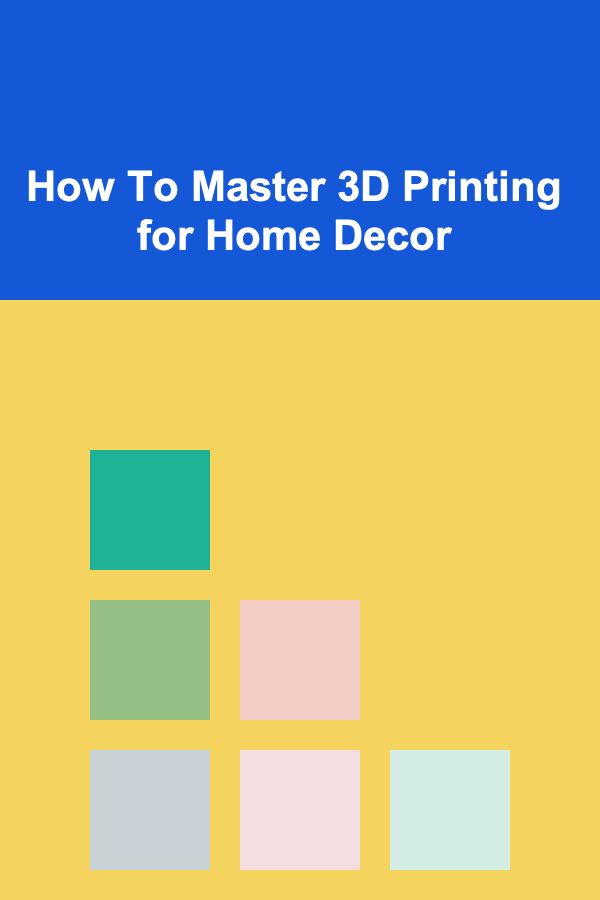
How To Master 3D Printing for Home Decor
ebook include PDF & Audio bundle (Micro Guide)
$12.99$5.99
Limited Time Offer! Order within the next:

3D printing, once a technology limited to industrial and prototyping applications, has rapidly become accessible to hobbyists, designers, and homeowners. As the technology continues to evolve, 3D printing for home decor has opened up a world of creative possibilities. From custom furniture and unique wall art to functional household objects, 3D printing offers a new way to personalize and elevate living spaces. In this comprehensive guide, we will explore how to master 3D printing for home decor, covering everything from the basics of the technology to advanced design techniques, practical applications, and tips for achieving professional-quality results.
What Is 3D Printing?
At its core, 3D printing is a process of creating three-dimensional objects by adding material layer by layer based on a digital model. This process, also known as additive manufacturing, contrasts with traditional manufacturing methods where material is subtracted or shaped. The versatility of 3D printing lies in its ability to create complex and customized shapes that would be difficult or impossible to achieve using conventional methods.
In recent years, consumer-grade 3D printers have become more affordable, making it possible for individuals to engage in 3D printing from the comfort of their homes. These printers can work with a variety of materials, including plastics, resins, metals, and even concrete, allowing for a wide range of home decor projects.
Getting Started with 3D Printing for Home Decor
Before diving into the intricacies of 3D printing for home decor, it's essential to understand the basics. Here's what you need to get started:
1. Choosing the Right 3D Printer
When selecting a 3D printer for home use, it's important to choose one that meets your specific needs for home decor projects. The two most common types of 3D printers for hobbyists are:
- FDM (Fused Deposition Modeling): This is the most common and affordable type of 3D printer for home use. FDM printers work by melting filament and extruding it layer by layer to build up an object. They are ideal for creating a wide range of home decor items, such as vases, sculptures, and furniture components.
- SLA (Stereolithography): SLA printers use a laser to cure liquid resin layer by layer, offering higher precision and smoothness in the finished product. This type of printer is ideal for smaller, intricate decor items such as jewelry, detailed figurines, and decorative accessories.
2. Selecting Materials for Home Decor Projects
The material you choose plays a crucial role in the durability, appearance, and functionality of your 3D-printed home decor pieces. Some popular materials for home decor printing include:
- PLA (Polylactic Acid): PLA is a biodegradable and easy-to-use plastic that is commonly used for 3D printing. It comes in a variety of colors and finishes, making it a great choice for decorative items. However, it is not as durable as other materials and may not be suitable for outdoor use.
- ABS (Acrylonitrile Butadiene Styrene): ABS is a more durable plastic that can withstand higher temperatures and is better suited for functional decor items such as custom furniture components. However, it requires a heated bed and a well-ventilated area for printing due to the fumes it releases during the process.
- PETG (Polyethylene Terephthalate Glycol): PETG is a flexible and durable plastic that is ideal for creating functional items like storage containers, trays, or lampshades. It is more resistant to impact and moisture than PLA, making it a good choice for practical decor pieces.
- Resins: For SLA printers, resins come in a variety of types, including standard, flexible, tough, and castable resins. Resin prints offer a higher level of detail and are often used for decorative objects or accessories that require a smooth finish.
3. Designing for 3D Printing
Once you have your 3D printer and materials set up, the next step is designing your home decor items. There are two primary ways to create a design:
- Modeling from Scratch: If you have experience with 3D design software, you can create your own models from the ground up. Popular design software options include Autodesk Fusion 360, Blender, and Tinkercad. These programs allow you to create highly customized and detailed designs for any type of home decor item.
- Using Pre-Made Models: If you're new to 3D modeling or simply want to get started quickly, there are many online platforms that offer free and paid 3D models. Websites like Thingiverse, MyMiniFactory, and Cults 3D have extensive libraries of models for home decor, including vases, planters, lamps, and sculptures. These pre-made models can be downloaded and printed without needing any modification.
Once you have your design ready, it's time to prepare it for printing. This step involves converting your model into a format that your 3D printer can understand, typically an STL (stereolithography) or OBJ file.
Tips for Successful 3D Printing of Home Decor Items
While 3D printing offers endless creative possibilities, achieving high-quality results requires attention to detail. Here are some tips to help you master the process and create stunning home decor pieces:
1. Understand Print Settings
Each 3D printer has its own set of settings that can affect the quality of the print. These settings include:
- Layer Height: The thickness of each layer of material. Finer layers (lower values) result in smoother prints but take longer to produce.
- Print Speed: The speed at which the printer extrudes material. Slower speeds can improve print quality, especially for detailed designs.
- Infill Density: The amount of material used inside the print. Higher infill densities provide more strength and durability but can make the print heavier.
- Support Structures: Some designs may require support structures to prevent overhangs or warping. These supports can be removed after printing.
Experimenting with these settings and adjusting them based on the complexity of your design can lead to better results.
2. Post-Processing for a Professional Finish
After your 3D print has completed, you may need to perform some post-processing to improve its appearance and functionality. This may include:
- Sanding: Smoothing the surface of the print to remove any visible layer lines or imperfections.
- Painting: 3D prints can be painted to add color and texture. Use acrylic paints or spray paints designed for plastic surfaces.
- Assembling: Some larger home decor pieces may need to be assembled from multiple printed parts. Ensure that the parts fit together properly before securing them with adhesive or screws.
Post-processing can transform a basic 3D print into a polished, professional-looking decor item.
3. Test for Functionality
If you're 3D printing functional decor items, such as furniture pieces or lighting fixtures, it's important to test the item for usability and durability. For example, if you're printing a custom lamp, ensure that the base can support the weight of the lamp, the wiring fits properly, and the material can withstand the heat generated by the light bulb.
Testing the functionality of your prints before placing them in your home will ensure that they serve their intended purpose and stand the test of time.
4. Experiment with New Design Techniques
As you become more comfortable with 3D printing, don't be afraid to experiment with new design techniques and advanced features of your printer. Some ideas include:
- Mixing Materials: Some 3D printers allow for dual extrusion, meaning you can print with two different materials or colors at once. This opens up creative possibilities for creating multicolored or multi-material decor items.
- Incorporating Light: 3D prints can be designed to hold LED lights, creating unique, illuminated decor items like lamps, nightlights, or wall art.
- Textured Finishes: Use texturing techniques in your designs to create visually interesting surfaces. For example, you can create patterns, organic textures, or even simulate wood or stone finishes.
Popular 3D Printing Projects for Home Decor
To inspire your own creations, here are some popular 3D printing projects for home decor that you can try:
- Custom Planters: Create unique plant pots and planters in various shapes and sizes to suit your home's aesthetic.
- Wall Art: Design intricate wall sculptures or geometric art pieces that add a modern touch to your living space.
- Furniture Components: Customize furniture with 3D-printed legs, handles, or brackets to create one-of-a-kind pieces.
- Lamps and Light Fixtures: Design custom lampshades or light fixtures that reflect your personal style, from minimalist to elaborate designs.
- Storage Solutions: Print functional storage items, such as boxes, trays, or drawer organizers, to help keep your home tidy.
Conclusion
Mastering 3D printing for home decor is a rewarding journey that allows you to express your creativity and create personalized items for your living space. Whether you're making custom furniture, decorative accessories, or functional home items, 3D printing provides an endless array of possibilities. By choosing the right printer and materials, learning the basics of design and printing, and experimenting with new techniques, you can unlock the full potential of this innovative technology and transform your home into a truly unique space.

How to Maximize Space in a Shared Bedroom
Read More
How to Maximize Storage in Your Bedroom with Built-In Solutions
Read More
How To Program Robots for Disaster Response
Read More
How to Use Mirrors to Enhance Shoe Display Areas
Read More
How to Prepare Delicious & Nutritious Smoothies
Read More
How to Master Visual Storytelling
Read MoreOther Products

How to Maximize Space in a Shared Bedroom
Read More
How to Maximize Storage in Your Bedroom with Built-In Solutions
Read More
How To Program Robots for Disaster Response
Read More
How to Use Mirrors to Enhance Shoe Display Areas
Read More
How to Prepare Delicious & Nutritious Smoothies
Read More